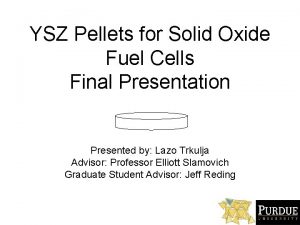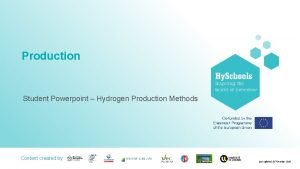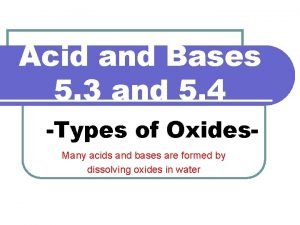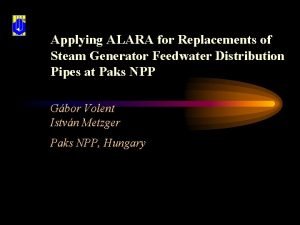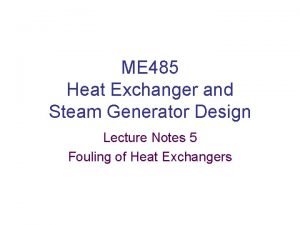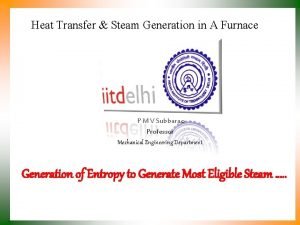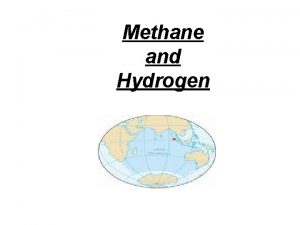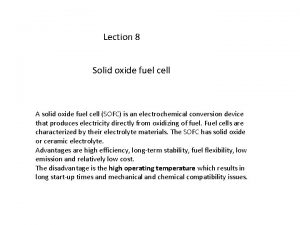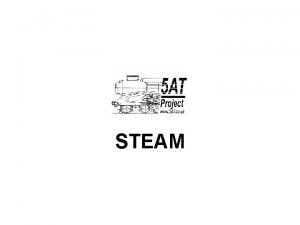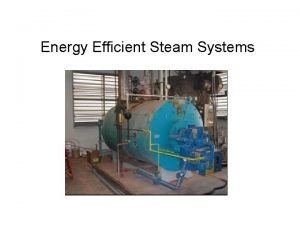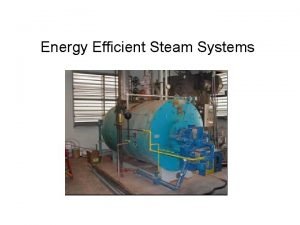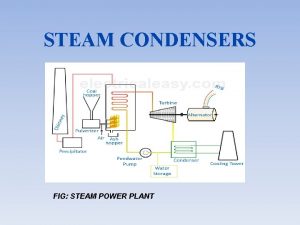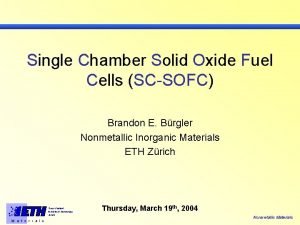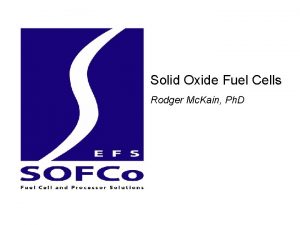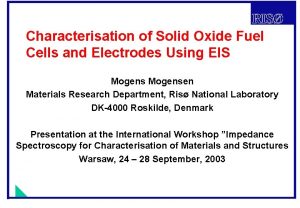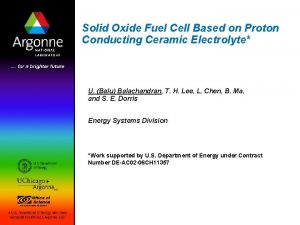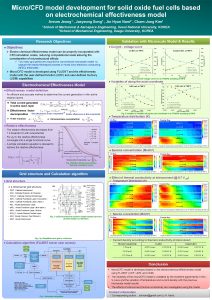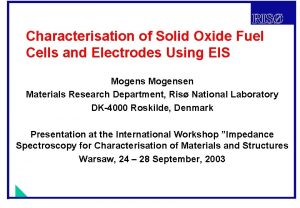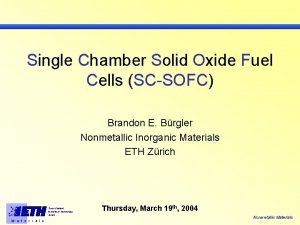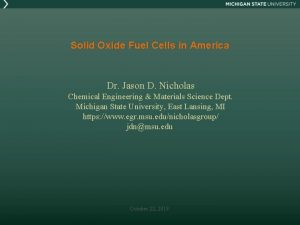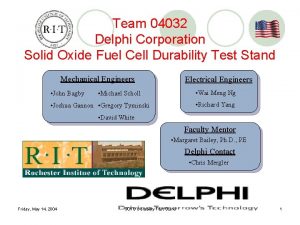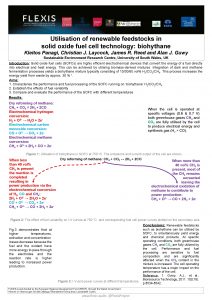STEAM METHANE REFORMATION FOR AIRINDEPENDENT SOLID OXIDE FUEL


















- Slides: 18

STEAM METHANE REFORMATION FOR AIR-INDEPENDENT SOLID OXIDE FUEL CELLS PRESENTER: KAMWANA MWARA 1

HESTIA ARCHITECTURE 2

WHY STEAM METHANE REFORMATION? BACKGROUND – The availability of LOx/CH 4 in the HESTIA-ISRU architecture, introduces Solid Oxide Fuel Cells (SOFCs) as an option, due to their ability to efficiently utilize those reactants. 3

WHY STEAM METHANE REFORMATION? INTRODUCTION – SOFCs can do internal reforming to convert CH 4 into H 2 to be used for fuel • – But would be optimal to reform methane externally first Utilizing an external steam methane reformer (SMR) would be the first step to creating a more efficient SOFC system 4

HESTIA SMR TESTING NEED: – Obtain data on SMR CH 4 conversion efficiencies and operating conditions, in support of HESTIA OBJECTIVE: – – – To design, develop, & in-house SMR system Determine optimal operating conditions, reactor design, fluid delivery, & heating Utilize lessons learned from in-house testing, to generate requirements for vendor-provided SMR integration with SOFC PHASES OF JSC IN-HOUSE TESTING: – – – Phase 1: Test reactor design based off of theoretical Matlab model Phase 2: Test refined reactor and system design Phase 3: Test optimized system design and new metal foam catalyst 5

SMR TESTING: PHASE 1 SYSTEM LAYOUT CATALYST Nickel Oxide Catalyst REASONS FOR SELECTION: – – Test # 1 2 3 Low cost Reasonably good efficiency Hot Flow Test (With Preheating of Gases) Steam to CH₄ Mass Flow H₂O Mass Flow SMR Methane Rate Temperature Ratio [g/min] [˚F] [mol/mol] 0. 982 1. 2 1 1020 0. 982 2. 3 2 1020 0. 982 3. 3 3 1020 System Pressure [psia] 14. 7 6

SMR TESTING: PHASE 1 GENERATED H 2 PRODUCTION, AND ALSO HIGH BUILD-UP OF UPSTREAM PRESSURE 7

SMR TESTING: PHASE 1 TEST RESULTS: – – Initial production of Hydrogen Carbon deposition blockage in the catalyst bed CONCLUSIONS: – – – Use of a kiln to produce steam No steam flow regulation (steam-to-methane ratio) Catalyst was not reduced: ������ +�� �� 2↔����+ 2�� PHASE 2 RECOMMENDATIONS: – – – Use syringe pumps to regulate water flow Use a separate heater to generate steam Reduce catalyst 8

SMR TESTING: PHASE 2 SYSTEM LAYOUT IMPROVEMENTS 9

SMR TESTING: PHASE 2 OBSERVED TEMPERATURE AND PRESSURE TRANSIENTS –AFFECTED H 2 PRODUCTION AT CERTAIN POINTS 10

SMR TESTING: PHASE 2 TEST RESULTS: – – Higher overall amount of hydrogen being produced Carbon deposition still being generated, though at lower rate Carbon deposition in test system CONCLUSIONS: – – Catalyst was not sufficiently reduced Need to increase thermal mass to heat up fluids to design temperatures Need to minimize hotspots that promote carbon deposition Essential to maintain consistent heating profile for input stream going into the reactor RECOMMENDATIONS: – – Obtain more robust catalyst Conduct one more round of testing, with system modifications 11

SMR TESTING: PHASE 3 SYSTEM MODIFICATIONS: Switched to new metal foam catalyst – for increased chemical stability and potential conversion efficiency Heat Transfer Mass Transfer Higher thermal conductivity minimizes temperature gradients & hot spots Porous structure provides more tortuous path for gas molecules Helps favor the reactions we want and prevent those we don’t Better dispersion of the active metals coated on the metal foam structure Ordered Pd/Rh coated SIC metal foam catalyst, machined to SMR physical dimensions with through-hole for high temperature probe 12

SMR TESTING: PHASE 3 SYSTEM MODIFICATIONS: – – Installed 3 -way valve downstream of steam generator, to help avoid T and P transients (circled in green) Installed heating tape between steam generator and reactor, to maintain consistent heating profile (circled in red) 13

SMR TESTING: PHASE 3 INITIAL TEST RUN – STEADIER TEMPERATURE AND PRESSURE RATES 14

SMR TESTING: PHASE 3 FINAL TEST RUN – STEADY PRESSURE FLOW, FLUCTUATINGH 2 PRODUCTION 15

SMR TESTING: PHASE 3 & TEST SUMMARY TESTING RESULTS: – Test prematurely ended due to leaking – – relief valve Eliminated carbon deposition Similar H 2 conversion rates to Phase 2 CONCLUSIONS/LESSONS LEARNED: – Ensure relief valve has captured venting – When possible, run higher flow rates in order to determine – whether conversion efficiency increases Potentially better to use water flow controller instead of syringe pumps SMR OVERALL TEST: 16

SMR TESTING: CURRENT DEVELOPMENT GOAL: – Private vendor Solid. Cell, Inc. to develop new SMR system • Based on technical requirements and direction provided by JSC, generated by lessons learned from in-house testing – SMR system to be integrated with existing JSC 1 k. W SOFC system – Develop more flight-like system, to include capacity for recirculation of SOFC product water and partial parasitic load capabilities – Test Conditions include: WHY: HOW: • • Water source: DI Water/SOFC Product water Operating Temperature ≥ 600 o. C Operating Pressure: 0 -15 psig Steam-to-Methane Molar Mixture Ratio: ≥ 3 17

SMR TESTING: WHAT’S NEXT TESTING: – SMR System to be delivered at end of May – Integration & testing with SOFC to happen by end of September (FY’ 16) – Afterward, integrated testing with SOFC, CFM, and other ISRU architecture • Use CH 4 from CFM boiloff DEVELOP MORE FLIGHT READY DESIGN: – Recirculate product gases, along with H 2 O – Enable SMR and supporting components act as a fully parasitic loads on SOFC – Contain SMR & SOFC in same furnace 18
 Solid oxide fuel cell
Solid oxide fuel cell Hydrogen production technologies ppt
Hydrogen production technologies ppt Acidic oxide
Acidic oxide Steam steam generator erosion
Steam steam generator erosion Heat recovery steam generator fouling
Heat recovery steam generator fouling Dittus boelter equation
Dittus boelter equation The reformation outcome: martin luther and the reformation
The reformation outcome: martin luther and the reformation Catholic reformation vs counter reformation
Catholic reformation vs counter reformation The reformation outcome martin luther and the reformation
The reformation outcome martin luther and the reformation Coal is a solid fossil fuel formed from plant remains
Coal is a solid fossil fuel formed from plant remains Covalent network solid vs molecular solid
Covalent network solid vs molecular solid Crystalline solid and amorphous solid
Crystalline solid and amorphous solid Examples of
Examples of Crystalline vs non crystalline
Crystalline vs non crystalline Crystalline solid and amorphous solid
Crystalline solid and amorphous solid Crystalline solid and amorphous solid
Crystalline solid and amorphous solid When a solid completely penetrates another solid
When a solid completely penetrates another solid Crystalline solids
Crystalline solids Example of a solid solution
Example of a solid solution
